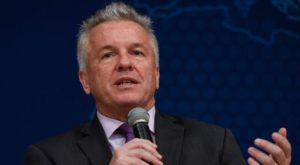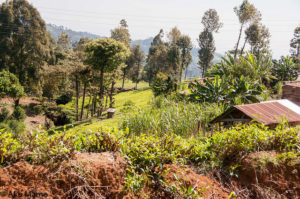
The second of three Global Landscapes Forum (GLF) in 2018 is being held at the UN headquarters in Nairobi, Kenya, on Aug. 29 to 30, with a focus on forest and landscape restoration.
The World Agroforestry Centre (ICRAF), one of the CGIAR Research Program on Forests, Trees and Agroforestry’s (FTA) partner institutions, is based in Nairobi, and its Director General Tony Simons is set to have some of the last words at this current GLF.
Simons is speaking in the Policy Plenary just before the conference finale, which will explore how to create enabling environments for transformational change in landscape management in the region.
Originally from New Zealand, Simons has an impressive track record working on issues at the interface of tropical agriculture and forestry in more than 40 developing countries. GLF’s Landscape News spoke with him about the potential he sees for policy change to help make forest landscape restoration work for ecosystems, people and profit across the African continent.
What are some of the issues for enabling sustainable landscapes in Africa at the moment?
Africa has tremendous opportunities, but it’s also got a lot of issues and difficulties. It’s the second largest continent in the world; the second most highly populated; the most rural; the poorest; and the most reliant on agriculture. It has the least forest cover; the highest use of wood energy; and it’s got one of the youngest populations in the world. There are very low levels of mechanization in agriculture: 95 percent of crops are rain-fed, and only 5 percent are irrigated.
Staggeringly, Africa imports 35 billion dollars a year of food. That’s going to be 110 billion by the year 2030. Of that 35 billion, 95 percent of that is brought in from other continents. So while there is plenty of land available – and people to work it – food production is not yet happening at the scale that it should be.

What policies need to change to help make landscapes more sustainable?
Back in 2009, the African Union [AU] heads of state passed a resolution on land use and management across the continent. It was at a time where there was a huge amount of attention on land grabbing. So the policy instruments put into place were about keeping the resource under sovereign control.
So that’s one of the issues in Africa now: about 75 percent of the land – even if it’s under customary control – is formally owned by the government. And the governments don’t really know what to do with it.
I think we’ve got to put land stewardship back in the hands of people. You’ve got the land; you’ve got a young population; you’ve got growing prosperity; better education; literacy and numeracy is growing; but there needs to be a kind of revolution in land management. It’s not going to be by individuals; it’s going to be by groups, collectives, communities and watersheds. We’ve got to leverage the agenda of that wise stewardship down to the level of the people.
Sustainable management costs money. How can we make it worth people’s while?
If you travelled to the world’s second largest rainforest, which is the Congo, and I sold you an acre of rainforest, it would cost about $10,000. But the government gets less than $100 of revenue from that per year: a 1 percent return. That’s the biggest problem with forests and wetlands: they’re not remunerative.
And that’s because we don’t count the value of all of the fantastic biodiversity, carbon provisioning, precipitation enhancement and other ecosystem services that these places provide. In a continent where 95 percent of crops are rainfed, forests are very important for agriculture. But protecting and restoring them is not remunerative because of the partial accounting. So that needs to change.
However, we’re not going to get anywhere if we spend all this money restoring the land to how it was in the past, because it will still be under pressure for exploitation. So we’ve got to make a viable business case for restoring that land. And that’s going to be about connecting and linking financial capital, natural capital, human capital and social capital.
This is also at a time when we’re seeing pressures on financing. So how do we get all of these new approaches and opportunities out to people? NGOs (non-governmental organizations) have stepped up in quite a large way, but the private sector needs to step up much more. And for that to happen, there are a number of things that we need to look at. The first one is the opportunities: where are the business cases, the viable enterprises to piggyback on?
The second thing to look at is investment return. What returns will the governments, the small-scale farmer, the community and the foreign investor get from investing in landscape restoration? And what are the risks associated with this, and how can we de-risk? Many people perceive agriculture as complicated, as confused, as risky, as having a low rate of return, as not really investment material. Investors need to see that yes, this is a viable enterprise, and when we start thinking about bringing that financial return to social dividends, to environmental dividends, that’s when it all starts to come together.

Beyond opportunity, risk and return, next comes leverage. We have been relying in Africa on external Overseas Development Assistance (ODA); but ODA is currently drying up and being reallocated. Now for every single dollar of ODA, there’s $3 of remittances, there’s $6 of Foreign Direct Investment (FDI), there’s $24 of domestic private sector spend, there’s $55 of national government spend, and there’s $1,000 of private capital.
So let’s use that $1 of ODA to leverage all those other sources. That’s going to be the real opportunity to bring change in landscapes.
What’s significant about having the GLF in Nairobi this year?
Africa is innovative and unique. Practitioners can take things that worked in Latin America and Asia and adapt them, but Africa also has some fantastic indigenous ways of understanding and transforming landscapes. For example, we’re already seeing in Ethiopia how social capital is driving land use change.
The GLF provides an important opportunity to showcase that it’s not just doom and gloom, and that things are progressing. Let’s make a business case for restoration. Let’s connect with people; let’s think about gender, land ownership and tenure, and about motivating the youth. We candrive confidence to investors to bring financing to restoration. It’s not just about ecosystem services; it’s all of humanity that stands to benefit from this.
To hear more from Tony Simons and other policy experts, tune into the Policy Plenary live stream on Thursday, Aug. 30, at 5.45pm Nairobi time (GMT+3).
By Monica Evans, first published at GLF’s Landscape News.











